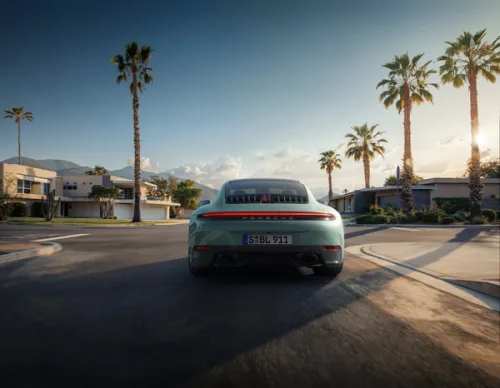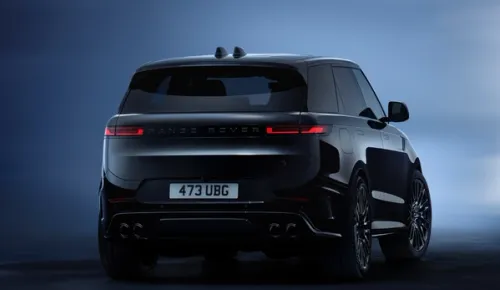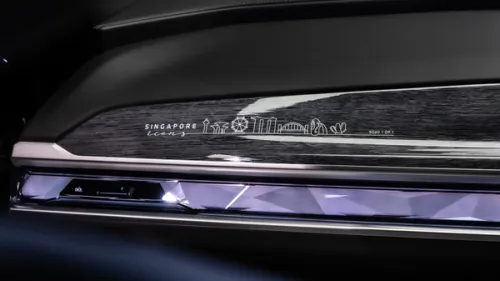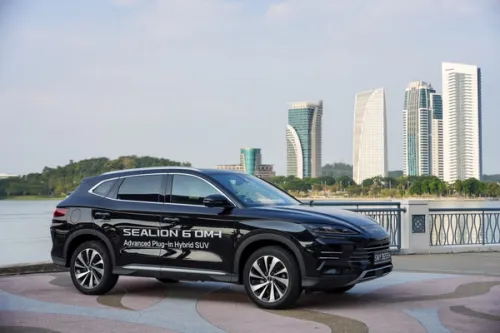Paris Motor Show: Audi E-Tron Spyder
Audi presents the Audi e-tron Spyder, the study of an open sports car


Audi presents the Audi e-tron Spyder, the study of an open sports car, at the Paris Motor Show 2010. The show car, with plug-in hybrid drive, is 4.06 metres long, 1.81 metres wide and only 1.11 metres high. The two-seater is equipped with a 300 bhp twin-turbo V6 TDI at the rear axle and two electric motors producing a total of 64 kW at the front axle.
The Audi e-tron Spyder’s low total weight of only around 1,450 kilograms combined with the high-torque TDI and the two electric motors results in respectable performance. The car accelerates to 100 km/h in just 4.4 seconds, and top speed is electronically governed at 250 km/h.
The e-tron Spyder can combine the powerful torque of its TDI – the diesel engine generates 650 Nm and the total of 352 Nm of its two electric motors during acceleration in a process known as “boosting.”
The intelligent distribution of power allows for optimal dynamics in every situation. The targeted application of power to the front wheels improves longitudinal dynamics while also improving lateral dynamics when cornering. This is because torque vectoring – the as-needed distribution of torque between the left and right wheels of the two axles – enables an exhilarating degree of driving precision and excellent agility.
Thanks also to its low weight, short wheelbase and perfect 50:50 weight distribution for dynamic handling, the Audi e-tron Spyder has all the drivability of a go-kart – good on bends and neutral right up to the very high handling limit.
The combination of a highly efficient TDI and electric drive also provides for excellent fuel economy and amazingly low emissions. The Audi e-tron Spyder requires on average just 2.2l diesel/100 km, corresponding to CO2 emissions of 59 g/km. A range of more than 1,000 kilometres is possible with the 50-litre tank.
The open sports car can also drive strictly on electric power and thus with zero emissions over distances of up to 50 kilometres, such as in urban areas. The top speed of 60 km/h is just fine for normal driving.
Audi has long proven the perfect synthesis between a highly advanced sports car and TDI technology. With the TT, Audi become one of the first manufacturers anywhere in the world to successfully bring a diesel sports car to market, a decade after the Audi Cabriolet paved the way for diesel engines in this segment. And the Audi R8 TDI Le Mans concept car was the first supercar to be fitted with a twelve-cylinder diesel engine with 500 bhp and 1,000 Nm of torque.
The Audi e-tron Spyder also draws on this recipe for success – albeit in a revolutionary new combination. This marks the first use of a new generation of the six-cylinder, 3.0 TDI that breathes through two turbochargers and produces 300 bhp. That is another 50 bhp more than the previous stage, which debuted a few months ago in the new Audi A8.
Peak torque of 650 Nm is unusually high, even in the sports car segment. The mid-mounted, longitudinal 3.0 TDI engine drives the rear wheels via a seven-speed dual-clutch transmission.
Another innovation is the coupling of the TDI with the electric drive of the front axle. Two asynchronous electric motors with a total output of 88 bhp and peak torque of 352 Nm combine with the 3.0 TDI to give the Audi e-tron Spyder the performance of a high-performance sports car. It accelerates from 0 to 100 km/h in 4.4 seconds. Top speed is electronically governed at 250 km/h.
The drive’s characteristic is even more exciting than the abstract numbers. Thanks in no small part to the fact that the peak torque of the electric motors is available immediately, the e-tron Spyder accelerates with catapult-like thrust. Short passing maneuvers on interurban roads can be pulled off as spurts that are every bit as relaxed as they are fun, even without having to downshift.
The noise level of the low-revving TDI is typically low. The six-cylinder unit behind the occupants issues a sonorously sporty growl under load, but never becomes loud. A surprising effect also present in the Le Mans-winning Audi R10 and R15 race cars, which are also powered by TDI engines.
The benefits of this special form of hybrid drive – the coupling of a high-torque, high-efficiency TDI engine with the electric motors – are by no means limited to the dynamic potential of the Audi e-tron Spyder, however. The open two-seater also sets new standards in its class for fuel consumption and environmental characteristics. The 300-bhp TDI consumes on average just 2.2 liters of diesel per 100 kilometres, which corresponds to CO2 emissions of only 59 g/km.
The full-hybrid Audi e-tron Spyder has also mastered the discipline of zero-emission driving. In residential and other urban areas, the driver can activate the electric drive by itself. The 9.1-kwH battery at the front of the car has enough power for up to 50 kilometres. And with a top speed of up to 60 km/h, the e-tron Spyder is also able to move along smartly in city traffic.
Credits: wilswong


Get the Best Price for your used car
from 500+ dealers in 24 hours

- Convenient and Hassle-Free
- Consumer Protection
Transparent Process
With No Obligation








